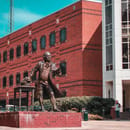If you survived the American public school system, you’ve likely learned our amazing continent was discovered by an Italian man, sailing across the Atlantic on the Niña, Pinta, and Santa Maria in search of India and spice trade riches.
Unfortunately, this story doesn’t quite capture the facts.
First off, Columbus wasn’t the first European to “discover” North America — Vikings beat him to it 5 centuries earlier. Upon stumbling across the Caribbean, Columbus then erroneously dubbed the Native Americans he met “Indians,” thus kicking off a solid 500 years of Native oppression that continues today.
Columbus is directly responsible for the decimation of the native Lucayan population of what we know today as the Bahamas. Columbus wrote in his diario about the Lucayans that “with 50 men they can all be subjugated and made to do what is required of them.” All Lucayans had been eradicated by 1520, and are today considered extinct.
Throughout the remainder of Columbus’ presence in the Caribbean, native people were routinely kidnapped and sent to Europe to be sold as slaves, during which many perished on the journey. Those who weren’t sold were forced to labor in gold mines and plantations.
Furthermore, the arrival of Spanish colonizers brought disease to the native population. As the world has so recently become aware of, pandemics are incredibly deadly. Historians estimate that the native Taino population of Hispaniola numbered roughly 250,000 in 1492. Only about 14,000 remained by 1592, falling victim to diseases like smallpox, measles, and influenza.
According to History.com, Columbus also had tyrannical tendencies during his sojourn as governor of the Dominican Republic. During a native uprising, Columbus “ordered a brutal crackdown” which resulted in the murder of many. He also “ordered their dismembered bodies to be paraded through the streets.”
European wealth, and eventually that of America as well, was built on the exploitation of native bodies and the theft of native land. For centuries, native people have been systematically removed from their ancestral lands and traditional way of life. Adequate change on this front has yet to be made, but I digress.
It’s time to strip Christopher Columbus of his legacy. Progress is being made — in several states across the country, Columbus Day is being replaced by Indigenous People’s Day.
This movement has not come without controversy, however. As pointed out by NPR, Italian Americans often view Christopher Columbus as a figurehead of “Italian heritage and the contributions of Italian-Americans to the United States.” Indeed, there was a time when Italians faced religious persecution and discrimination in America (for example, the largest lynching in American history). Columbus Day was introduced as a federal holiday at a point in time where Italian immigrants were not accepted as Americans.
However, I feel entirely comfortable making the statement that the struggle of Italian-Americans was not, and is not, comparable in any way to the systemic oppression of Native Americans in this country. Speaking as a dual American and Italian citizen, I feel that Columbus Day should be eradicated and all statues torn down.
There must be a better way to honor Italian-American heritage without glorifying a colonizer who never actually set foot on the North American continent.



